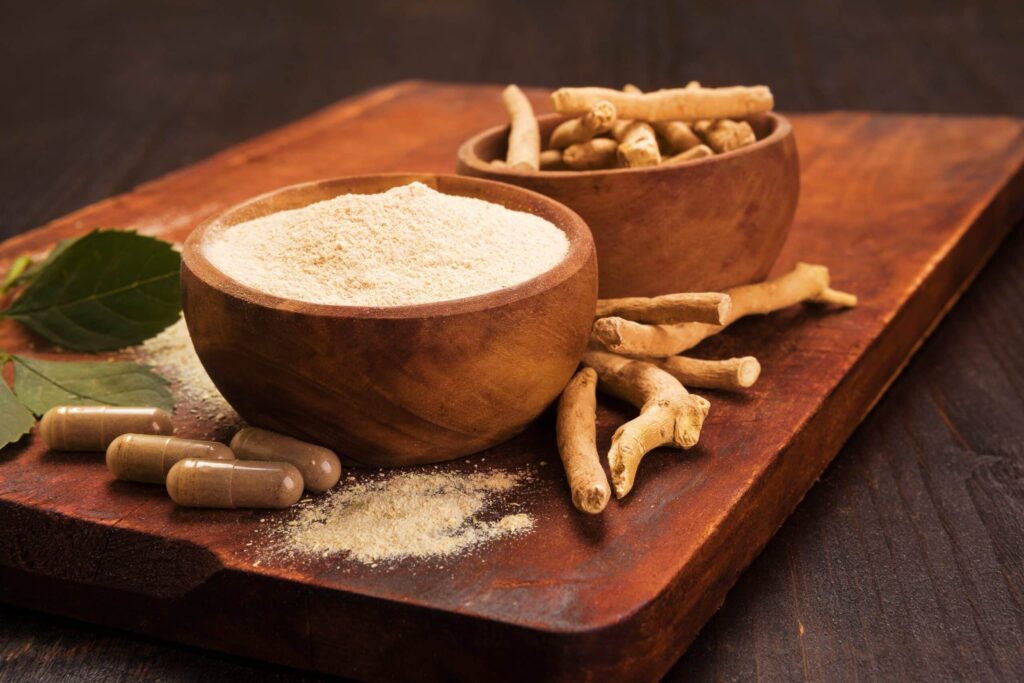- Bucci LR. Selected herbals and human exercise performance. Am J Clin Nutr. 2000; 72:624S– 636S. [PubMed: 10919969].
- Dhar N, Razdan S, Rana S, Bhat WW, Vishwakarma R, Lattoo SK. A Decade of Molecular Understanding of Withanolide Biosynthesis and In vitro Studies in Withania somnifera (L.) Dunal: Prospects and Perspectives for Pathway Engineering. Front Plant Sci. 2015 Nov 27;6:1031. doi: 10.3389/fpls.2015.01031. eCollection 2015. Review. PubMed PMID: 26640469; PubMed Central PMCID:PMC4661287.
- Dhar N, Razdan S, Rana S, Bhat WW, Vishwakarma R, Lattoo SK. A Decade of Molecular Understanding of Withanolide Biosynthesis and In vitro Studies in Withania somnifera (L.) Dunal: Prospects and Perspectives for Pathway Engineering. Front Plant Sci. 2015 Nov 27;6:1031. doi: 10.3389/fpls.2015.01031. eCollection 2015. Review. PubMed PMID: 26640469; PubMed Central PMCID:PMC4661287.
- Singh-Manoux A, Kivimaki M, Glymour MM, Elbaz A, Berr C, Ebmeier KP, et al. Timing of onset of cognitive decline: results from Whitehall II prospective cohort study. Brit Med J. 2012;344:d7622. doi:10.1136/bmj.d7622.
- Choudhary D, Bhattacharyya S, Bose S. Efficacy and Safety of Ashwagandha (Withania somnifera (L.) Dunal) Root Extract in Improving Memory and Cognitive Functions. J Diet Suppl. 2017 Nov 2;14(6):599-612. doi:10.1080/19390211.2017.1284970. Epub 2017 Feb 21. PubMed PMID: 28471731.
- Jenike M.A.: Obsessive-compulsive disorder: efficacy of specific treatments as assessed by controlled trials. Psychopharmacol Bull 1996; 29: pp. 487-499.
- Soomro G.M., Altman D., Rajagopal S., and Oakley-Browne M.: Selective serotonin re-uptake inhibitors (SSRIs) versus placebo for obsessive compulsive disorder (OCD). Cochrane Database Syst Rev 2008; 1:
- Swinson R.P., Antony M.M., Rachman S., and Richter M.A.: Obsessive-compulsive Disorder: Theory, Research and Treatment. Guilford Press, 2001.
- Goodman W.K., McDougle C.J., and Price L.H.: Pharmacotherapy of obsessive compulsive disorder. J Clin Psychiatry 1992; 53: pp. 29-37.
- Jahanbakhsh SP, Manteghi AA, Emami SA, Mahyari S, Gholampour B, Mohammadpour AH, Sahebkar A. Evaluation of the efficacy of Withania somnifera (Ashwagandha) root extract in patients with obsessive-compulsive disorder: A randomized double-blind placebo-controlled trial. Complement Ther Med. 2016 Aug;27:25-9. doi: 10.1016/j.ctim.2016.03.018. Epub 2016 Apr 9. PubMed PMID: 27515872.
- Agnihotri AP, Sontakke SD, Thawani VR, Saoji A, Goswami VS. Effects of Withania somnifera in patients of schizophrenia: a randomized, double blind, placebo controlled pilot trial study. Indian J Pharmacol. 2013 Jul Aug;45(4):417-8. doi: 10.4103/0253-7613.115012. PubMed PMID: 24014929; PubMed Central PMCID: PMC3757622.
- MURTHY MNK, GUNDAGANI S, NUTALAPATI C, PINGALI U. Evaluation of Analgesic Activity of Standardised Aqueous Extract of Withania somnifera in Healthy Human Volunteers using Mechanical Pain Model. Journal of Clinical & Diagnostic Research. 2019;13(1):1. http://search.ebscohost.com/login.aspx?direct=true&AuthType=shib&db=edb&AN=134212650&site=eds-live&scope=site. Accessed December 8, 2019.
- Rasool M, Varalakshmi P. Suppressive effect of Withania somnifera root powder on experimental gouty arthritis: An in vivo and in vitro study. Chem Biol Interact. 2006 Dec 15;164(3):174-80. Epub 2006 Nov 7. PubMed PMID: 17084827.
- Chandrasekhar K, Kapoor J, Anishetty S. A prospective, randomized double-blind, placebo-controlled study of safety and efficacy of a high-concentration full-spectrum extract of ashwagandha root in reducing stress and anxiety in adults. Indian J Psychol Med. 2012 Jul;34(3):255-62. doi:10.4103/0253-7176.106022. PubMed PMID: 23439798; PubMed Central PMCID:PMC3573577.
- Shohat B, Gitter S, Abraham A, Lavie D. Antitumor activity of withaferin A (NSC-101088). Cancer Chemother Rep. 1967; 51:271–276. [PubMed: 6062297]
- Sporn MB, Dunlop NM, Newton DL, Smith JM. Prevention of chemical carcinogenesis by vitamin A and its synthetic analogs (retinoids). Fed Proc. 1976; 35:1332–1338. [PubMed: 770206]
- Khazal KF, Hill DL, Grubbs CJ. Effect of Withania somnifera root extract on spontaneous estrogen receptor-negative mammary cancer in MMTV/Neu mice. Anticancer Res. 2014; 34:6327–6332. [PubMed: 25368231]
- Tejeda-Maldonado J, Garcı´a-Jua´ rez I, Aguirre-Valadez J, et al. Diagnosis and treatment of hepatocellular carcinoma: An update. World J Hepatol 2015; 7: 362–376.
- Ahmed W, Mofed D, Zekri AR, El-Sayed N, Rahouma M, Sabet S. Antioxidant activity and apoptotic induction as mechanisms of action of Withania somnifera (Ashwagandha) against a hepatocellular carcinoma cell line. J Int Med Res. 2018 Apr;46(4):1358-1369. doi: 10.1177/0300060517752022. Epub 2018 Feb 2. PubMed PMID:29392963; PubMed Central PMCID: PMC6091842.
- Palliyaguru DL, Singh SV, Kensler TW. Withania somnifera: From prevention to treatment of cancer. Mol Nutr Food Res. 2016 Jun;60(6):1342-53. doi:10.1002/mnfr.201500756. Epub 2016 Jan 29. Review. PubMed PMID: 26718910; PubMed Central PMCID: PMC4899165.
- Lopresti AL, Drummond PD, Smith SJ. A Randomized, Double-Blind, Placebo-Controlled, Crossover Study Examining the Hormonal and Vitality Effects of Ashwagandha ( Withania somnifera) in Aging, Overweight Males. Am J Mens Health. Mar-Apr 2019;13(2):1557988319835985.
- Shukla SD, Bhatnagar M, Khurana S. Critical evaluation of ayurvedic plants for stimulating intrinsic antioxidant response. Front Neurosci. 2012;6:112.
- Shukla SD, Bhatnagar M, Khurana S. Critical evaluation of ayurvedic plants for stimulating intrinsic antioxidant response. Front Neurosci. 2012;6:112.
- Dey D, Chaskar S, Athavale N, Chitre D. Acute and chronic toxicity, cytochrome p450 enzyme inhibition, and HERG channel blockade studies with a polyherbal, ayurvedic formulation for inflammation. Biomed Res Int. 2015; 2015:971982. [PubMed: 25893199]
- Kuboyama T, Tohda C, Komatsu K. Effects of Ashwagandha (roots of Withania somnifera) on neurodegenerative diseases. Biol Pharm Bull. 2014;37(6):892-7. Review. PubMed PMID: 24882401.
×
Why Choose to Autoship?
- Automatically re-order your favorite products on your schedule.
- Easily change the products or shipping date for your upcoming Scheduled Orders.
- Pause or cancel any time.






